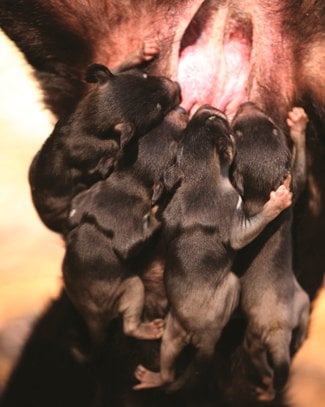40 Tassie devil babies boost ark population

THEY ARE A LONG WAY from home, but the 40 Tasmanian devil joeys born this year in the mist-shrouded hills north of Barrington Tops, in NSW, are a lifeline for the species.
Still in pouches, the young are the latest additions to a population of more than 100 Tasmanian devils living at Devil Ark, a 500ha breeding facility that was founded in 2010 to safeguard the species from extinction. Located at Tomalla Station, at an altitude of 1350m, the site has a similar climate and topography to the devils’ native Tasmania. (See a VIDEO about Devil Ark)
In the wild, Tasmanian devils are fighting a losing battle against Devil Facial Tumour Disease (DFTD), a transmissible cancer – recently thought to be parasitic in nature – that was first reported in 1996 and has already reduced their numbers by about 85 per cent.
“Any hopes of resistant animals in the wild are fading,” says Adrian Good, a supervisor at Devil Ark. “It’s inevitable that the disease will wipe out the wild Tasmanian devil population, so we’re breeding a genetically viable insurance population that we can eventually release back into Tasmania.”
 Some of the 40 Tasmanian devil babies born this year at Devil Ark in the Barrington Tops. (Credit: Mandy Kennedy)
Some of the 40 Tasmanian devil babies born this year at Devil Ark in the Barrington Tops. (Credit: Mandy Kennedy)Tasmanian devil insurance population growing
This year, the devils at Tomalla Station took part in the program’s second breeding season and Adrian is pleased with the results.
“The way we determine our success is by the number of females that breed [rather than by the number of joeys each produces] because we want as much representation from our females as possible,” he says.
There are 23 females of reproductive age in the breeding program, and 14 of these successfully produced joeys this year. “In the wild you get about a 50 per cent strike rate with females producing young and we’re well above that so we’re quite excited,” Adrian told Australian Geographic. “It tells us that what we’re doing is working, and that’s a big deal for us.”
Tasmanian devils reach sexual maturity at about two years of age and have a three-year reproductive window. They undergo an annual breeding season from February to July, and a female can suckle up to four joeys in her pouch at a time.
Although it’s possible for a female to produce 12 joeys during her lifespan (four each year, for three years), it is uncommon and most only carry one, two or three in their second and third season. Despite the species’ slow breeding rates, Adrian hopes to see this year’s successes recur in 2013 and he says the program is on track to achieve its goal of housing 360 healthy devils by 2016.
Adrian and his team will regroup the devils in December based on genetic recommendations for next year’s breeding season.
“We manipulate who breeds with who so we can reinvigorate the gene pool and get genetic diversity back into the species, which is crucial for their survival,” says Adrian who notes that by achieving a high level of genetic diversity in captive-breeding programs, the animals will have the best-possible chance of successfully repopulating Tasmania upon their release.
Breeding Tasmanian devils close to wild
“The other important thing we do is try to replicate a wild-type scenario so the Tasmanian devils don’t lose their wild traits,” he says.
The devils are kept in free-range yards and are mostly left to their own devices, with little human interference. “It’s crucial that their natural instincts are retained so that when the time does come, we can release a wild-type Tasmanian devil back into Tasmania.”
Devil Ark is at the forefront of Tasmanian devil conservation. According to Professor Kathy Belov from the University of Sydney, who has conducted extensive research into DFTD, captive-breeding programs are critical for the survival of the species.
“Our recent research has shown that the tumour affecting Tasmanian devils shows no signs of slowing down and in fact seems to be getting more aggressive,” she says. “Captive breeding of Tasmanian devils is critical and Devil Ark is leading the way.”
RELATED STORIES

